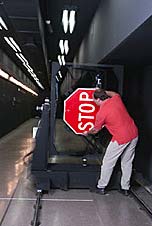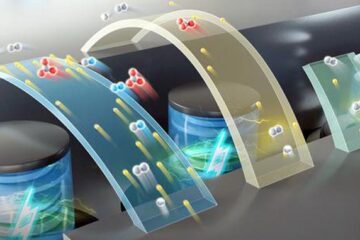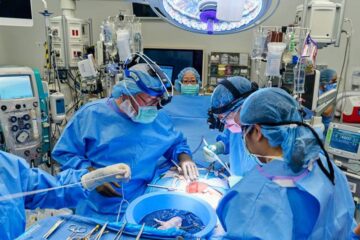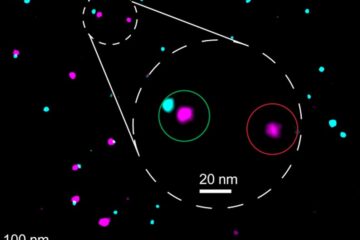New NIST Facility Soon Will Be ‘Reflecting’ on Safer Signs

© R. Rathe
Our roadways should get safer in the future, now that the National Institute of Standards and Technology (NIST) has developed a way to accurately and reliably measure how light reflects off stop signs and other road markings.
Road signs and markings are designed to be visible at night by retroreflectivity—that is, they reflect some of the light emitted by a vehicle’s headlights back toward the driver’s eyes. However, measurements of retroreflectivity have varied so much among different devices and laboratories that federal transportation officials have been unable to define minimum standards for this Congressionally mandated characteristic.
Recently, NIST established a facility—funded by the Transportation Research Board of the National Cooperative Research Program—that resolves numerous measurement problems and improves accuracy. Inside the facility, one finds a long black tunnel with a set of tracks on which sits an instrumented platform. Signs or materials are mounted on the platform, which can be moved 3 to 30 meters (10 to 100 feet) from a light source at one end of the tunnel. Using custom software, scientists precisely control all of the components and measure the characteristics of light reflected from the sign to a detector located close to the source.
NIST expects that the facility will begin providing calibration services early in 2004.
Media Contact
More Information:
http://www.nist.gov/public_affairs/techbeat/tb2003_0811.htm#signsAll latest news from the category: Transportation and Logistics
This field deals with all spatial and time-related activities involved in bridging the gap between goods and people, including their restructuring. This begins with the supplier and follows each stage of the operational value chain to product delivery and concludes with product disposal and recycling.
innovations-report provides informative reports and articles on such topics as traffic telematics, toll collection, traffic management systems, route planning, high-speed rail (Transrapid), traffic infrastructures, air safety, transport technologies, transport logistics, production logistics and mobility.
Newest articles

High-energy-density aqueous battery based on halogen multi-electron transfer
Traditional non-aqueous lithium-ion batteries have a high energy density, but their safety is compromised due to the flammable organic electrolytes they utilize. Aqueous batteries use water as the solvent for…

First-ever combined heart pump and pig kidney transplant
…gives new hope to patient with terminal illness. Surgeons at NYU Langone Health performed the first-ever combined mechanical heart pump and gene-edited pig kidney transplant surgery in a 54-year-old woman…

Biophysics: Testing how well biomarkers work
LMU researchers have developed a method to determine how reliably target proteins can be labeled using super-resolution fluorescence microscopy. Modern microscopy techniques make it possible to examine the inner workings…





















